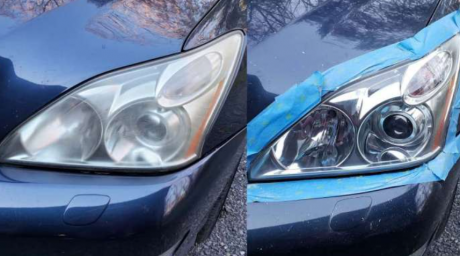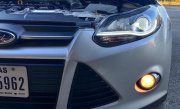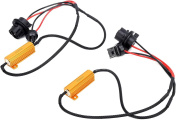
Headlights are an important part of a car and its driver’s safety. They provide light so you can see at night and in bad weather conditions. But over time, they can fog up, making it harder to see at night. Are your headlights yellow day by day and you don't know what to do about it? In this article, we are going to talk about the methods of preventing headlights from getting cloudy.
What causes headlights to yellow?

So, the first question that comes to your mind is 'why do headlights fog up?'. Believe us, you're not the only one asking this question. In fact, it's a pretty common issue. Here we will uncover some of the most common reasons for headlights getting cloudy.
- Sun damage is the most common reason for yellowing headlights
The sun's ultraviolet rays can break down the plastic and cause it to turn yellow. UV light will also make the plastic less clear, which will reduce the light output. That is because usually sun rays affect the surface of the headlight, making it look hazy.
- Heat can also cause headlights to yellow
When plastic is exposed to high temperatures, it will turn yellow. This is because the heat causes the plastic to break down. The same thing happens when you leave your car in the sun for a long period of time.
- Chemical cleaners can damage headlights
Some chemical cleaners can actually damage the plastic of your headlights. That is why it's important to read the labels carefully and avoid using any cleaners that contain harsh chemicals.
- Road debris can scratch and dull your headlights
Road debris, such as stones and sand, can scratch the surface of your headlights. This will make them look dull and yellow over time. The top layer of your headlights is damaged by gravel, road salt, and other debris that flies up as you drive down the street. The top coat is worn away, leaving pits and scratches on your headlights, which gives them a hazy appearance.
- Water vapor
Sometimes when drivers go through a car wash, they notice that their headlights turn yellow shortly after. This is because the water vapor from the car wash can actually cause the headlights to fog up.
All these cases are the main reasons for headlights getting yellow. But don't worry, there are ways to prevent it and even to restore your headlights.
How to prevent headlights from getting cloudy?
First, let`s look at the easiest and the most obvious methods. When you park your car in the sun, the UV rays can damage the plastic of your headlights. So, it's best to park in the shade or in a garage if possible. This will help to protect your headlights from sun damage. Also, headlight covers are a great way to protect your headlights from scratches, UV rays, and other debris. They are made of clear plastic or vinyl and fit over your headlights. Of course, polishing your headlights is always an option. When they become cloudy and foggy, you can use a headlight restoration kit to make them look new again.
There are also some methods that are not that obvious. For example, using a UV protectant spray. This type of spray helps to protect your headlights from UV rays, which can cause them to yellow over time. You can find these sprays at most auto parts stores. Another way to prevent your headlights from getting cloudy is to wash them regularly. This will help to remove any debris that could scratch or dull the surface of your headlights. You should also wax your headlights on a regular basis. This will help to create a barrier between the headlight and the elements.

Get rid of this effect
Some home products are very effective when it comes to getting rid of this effect. You can use toothpaste, for example.
Toothpaste:
This product is in every house and it can be used for different purposes, including cleaning headlights. Apply toothpaste to a damp cloth and rub it onto the headlight. Then, use a clean cloth to wipe off the toothpaste. Never select a toothpaste with gel or other abrasives.
Baking soda:
This is another product that can be found in every kitchen. Make a paste of baking soda and water. Take two spoons of baking soda and one spoonful of water. Apply the paste to your headlight and rub it in using a circular motion. Then, use a clean cloth to wipe off the paste.
Lemon or orange:
Some drivers tell that the most effective and eco-friendly way to clean headlights is to use lemon or orange. These fruits are rich in citric acid, which is a natural cleanser. All you need to do is to cut the fruit in half and rub it onto the headlight.
Vinegar:
Vinegar is another product that can be found in every kitchen. It's very effective when it comes to cleaning different surfaces, including car headlights. You can mix vinegar and water in equal proportions and apply the solution to your headlight. Rub it in using a circular motion and then wipe it off with a clean cloth.
Professional tools
Here we will tell you about those tools that will help you to achieve the best results.
Headlight restoration kit:
If your headlights are severely damaged, you may need to use a headlight restoration kit. These kits usually come with sandpaper, polishing pads, and cleaning solutions. Follow the instructions that come with the kit to restore your headlights.
Sanding:
Your cloudy headlights can be restored by sanding them. You will need to use wet/dry sandpaper with a grit of 2000 or higher. Wet the headlight and then sand it in a circular motion. Continue until the headlight is clear. Then, use a clean cloth to wipe off any residue.
Polishing:
After you have sanded your headlights, you will need to polish them. You can use a polishing compound or a headlight restoration kit. Apply the polish to your headlight and rub it in using a circular motion. Polishing will prevent headlights from getting cloudy.

Sealing:
Another option that many professionals use is sealing. This is a good option if you want to protect your headlights from future damage. There are many headlight sealants on the market. Choose one that is durable and easy to apply. Follow the instructions that come with the sealant to apply it properly. In general, the application process is very simple. You just need to apply the sealant to a clean headlight and then let it dry.
These were some tips on how to prevent your headlights from getting cloudy. We hope that you will find them helpful.
FAQ
Will WD 40 clean foggy headlights?
If you have an upcoming car test and are wondering if you can quickly defog your headlights for approval, the answer is yes! In fact, WD-40 consists of a mixture of mineral oils and petroleum-based chemicals, which work to clean, protect and lubricate surfaces. When used on car headlights, it can help to quickly remove any built-up residue or grime. Simply apply a small amount of WD-40 to a clean cloth and wipe over the surface of your headlights in a circular motion. Buff away any excess with another clean cloth and voila – you should have sparkling clean headlights!
Please note that while WD-40 will help to clean your headlights in the short term, it is not a long-term solution for preventing fogging and will need to be reapplied regularly. For a more permanent fix, we recommend using one of the methods mentioned above.
Does rubbing alcohol clear headlights?
When finished with the cleaning process, wipe the headlight with rubbing alcohol to help it dry (this helps the headlight dry). Everything should appear clear at this point, but as a finishing touch, polish the plastic with toothpaste (like above) or a specialized headlight polish. Rubbing alcohol will not only clean your headlights but also help to prevent them from getting cloudy.
Is it OK to wax plastic headlights?
You can use wax on the headlight as an extra measure to help prevent deterioration.
One method suggests using bug spray to get rid of the foggy appearance. However, don't use this method unless you want permanent damage to the plastic. That is because the chemicals in bug spray can break down the material of your headlights. If you want to use this method, make sure to apply a coat of wax or sealant afterward.
Moreover, plastic headlights may become yellow over time. This is due to a process called oxidation. When the plastic is exposed to sunlight, oxygen, and water, it will slowly turn yellow. You can prevent this by waxing your headlights or using a headlight sealant.

Does Coca-Cola clean foggy headlights?
You may transform the Coca-Cola beverage into a spray bottle or soak a sponge or a towel in it and apply it to your foggy headlights. Allow 10 minutes for soaking, then wipe your lights with a clean towel. That is because Coke contains acid that will help to eat away at the grime on your headlights. Coca-Cola is one of many household items that can be used to clean your headlights. But, just like WD-40, it is not a long-term solution and you will need to reapply it regularly.
Bottom line
So, when automobilists want to prevent headlights from getting cloudy and yellow, there are several things they can do. First, they can clean the headlights with soapy water and a soft cloth. If the headlights are very dirty, they can use a toothbrush to scrub away the dirt. Then, they can dry the headlights with a clean cloth. Next, they can apply a coat of wax or sealant to protect the headlights from future damage. Finally, if the headlights are still foggy, they can use WD-40 or Coca-Cola to clean them. However, these solutions will only work in the short term and will need to be reapplied regularly. For a more permanent fix, we recommend using one of the methods mentioned above.








